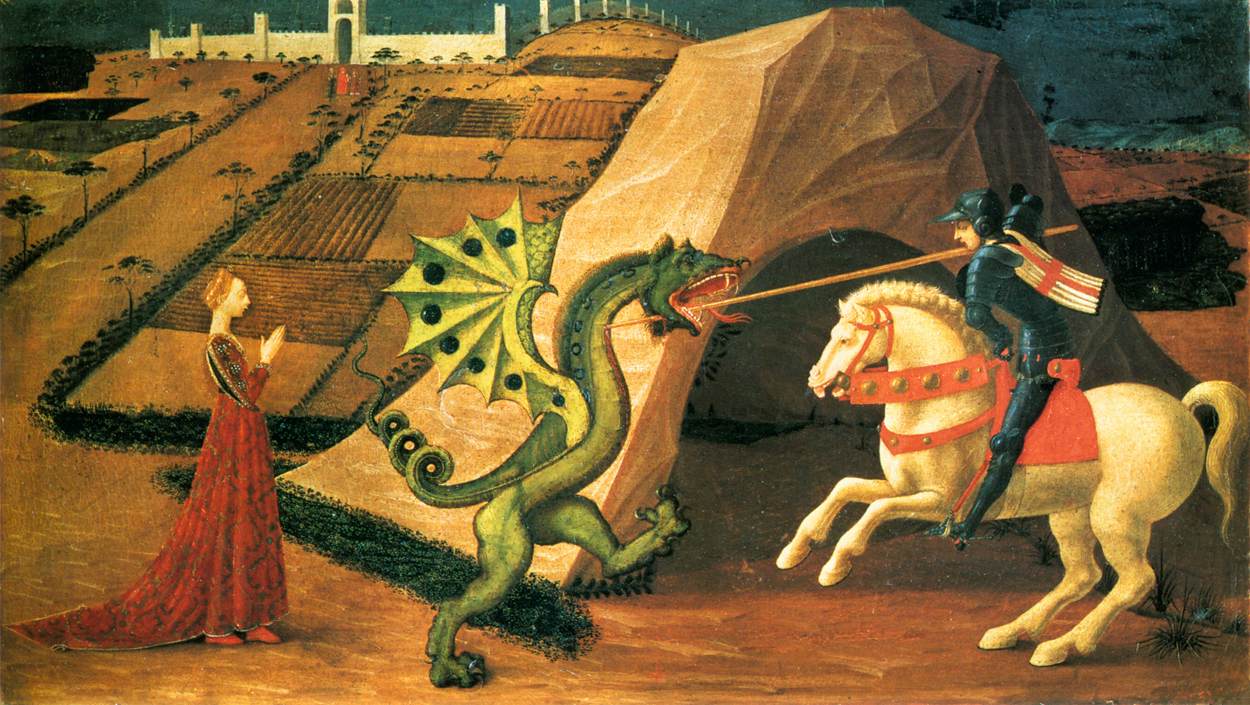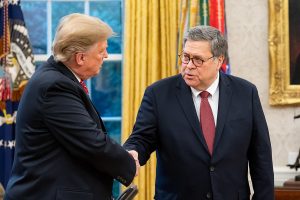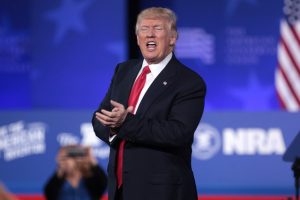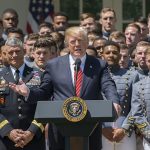by John Feffer
Once upon a time, long, long ago, I testified before the great assembly of our land.
When I describe this event to children today, it really does sound to them like a fairy tale. Once upon a time — a time before the world splintered into a million pieces and America became its current disunited states — this old woman was a young idealist who tried to persuade our mighty Congress that a monster was stalking the land.
“Did they listen to you, Auntie Rachel?” they typically ask me.
“Oh, they listened to me, but they didn’t hear me.”
“So, what did you do?”
“I thought and I thought, and I wrote and I wrote, and I put together an even better presentation,” I say patiently. “I had to somehow make that monster visible so those mighty people could see it.”
“What did it look like, Auntie Rachel?”
“It was invisible, my dear children, but we could feel its hot breath. And we could see the terrible things that it did. It could make the oceans rise. It could make the crops wilt in the fields. Still, we kept feeding this terrible beast.”
“But why?”
“It’s what the monster demanded. Some monsters want to devour little children. Others insist on young maidens. But this one insisted on tankers of oil and truckloads of coal. Even as it grew, it only demanded more and more.”
At this point, the children are always wide-eyed. “What did you do then?”
“I talked to those great people again. And this time I tried even harder to describe the monster.” As I slip into the past, the faces of the children become those of long-dead politicians. “I provided more detailed graphs of rising temperatures. I cited statistics on the impact of burning coal and oil and natural gas. I displayed photos of what the melting ice and the surging waters had already done. And then I showed them pictures of what the future would look like: submerged cities, drought-stricken lands, dead seas. They looked and still they didn’t see. They listened and still they didn’t hear. Great people,” I conclude, “are not always good people.”
“What did you do then?” they always ask.
“I stopped talking, my darlings. I came here to escape the monster. I came to Arcadia.”
They look disappointed. The children know their fairy tales. They expect someone — perhaps a knight in shining armor — to appear suddenly and slay the monster.
“There was no knight,” I lament. “And the monster still lives. We can feel its hot breath even now.”
Of course, my young charges don’t really understand my story. Today, in 2050, there is no Congress. There are no committee hearings. There are no intergovernmental panels or global gatherings. I might as well be telling them about Roman banquets or medieval jousts. And yet my little students always clamor for more stories of the vanished world of Washington, D.C., 2017, just as they would beg for yet another of Aesop’s fables. But they don’t quite see how these tales of long ago connect to their lives today.
After all, they live in a post-political world.
The Death of Politics
Before the global thermometer went haywire, before the great economic panics of the early 2020s, before the battles escalated between vigilantes and jihadis, before the international community cracked like a mirror smashed by a fist, there was that initial death, which was barely noticed at the time.
As the historians — those left to tell the tale — will inform you, there were no funerals for the death of politics, nor were there obituaries. And even if there had been, few would have shed any tears. The confidence the American public had in Congress back in those days was lower than in any other institution — a mere 9% had such confidence, compared to 18% for big business and 73% for the military.
Politics in the muggy swamp of Washington, where I lived in those antediluvian years, had become a tug of war between two hated teams. Sometimes, one side won and dragged the other through the muck. Then the situation would be reversed. No matter: at the end of the day, everyone was left covered in mud.
Yes, things might have turned out differently. Radical reforms might have been enacted, a new generation of politicians cultivated. But at the moment of greatest peril — to the republic and the world at large — Americans turned their backs on politics, electing the most anti-political candidate in the history of the country. The founding fathers had done everything they could to ensure that the system would not produce such a result, but there was no way they could have anticipated Donald Trump or the circumstances that put him in power.
When the initial Europeans arrived in North America more than half a millennium ago, they brought weapons far more powerful than the stone axes and wooden clubs wielded by the First Nations. But it wasn’t just the guns that proved so devastating. The Europeans carried within them something far more lethal: invisible diseases like smallpox and the flu. Those viruses cut through the Native Americans like so many scythes, killing nine out of every ten of the original inhabitants of this continent.
Many centuries later, Donald Trump arrived in Washington armed with the explicit weapons of extremist rhetoric and sociopathic sangfroid with which he had destroyed his political opponents. But it was what he carried hidden within him that would ultimately turn out to be so catastrophic. Although he had railed against the political establishment in the election campaign that put him in the Oval Office, in his own way he had also played by the political rules to get there. Deep down, however, his greatest urge was to destroy politics altogether: tweet by tweet, outrage by outrage.
And his attack on politics would finish off the world as we knew it in Washington circa 2017. In the end, it would render congressional testimony and Congress itself irrelevant. Even today, more than 30 years later, the bodies are still piling up.
The Judgment of Paris
I teach science to the young children here in Arcadia. It’s not difficult to explain the basic scientific concepts that so changed our world, and we have a well-equipped lab for them to run experiments. So they understand the science of climate change. What bewilders them is how the crisis came about.
“Why didn’t our grandparents run the factories every other day?” a bright young girl once asked me. “Why didn’t they drive those stupid cars just on the weekend?”
Our children know little but Arcadia, and this community is fully sustainable. We produce everything we need here in this corner of what was once the Northeast Kingdom of Vermont. What we don’t grow, we synthesize or create on our 3-D printers. We conduct limited trade with the few neighboring communities. If there is an unexpected death, we issue another birth permit. If our solar batteries run low during the winter, we ration energy. Everything is recycled, from our chicken bones to our night soil. The children of Arcadia don’t understand waste.
They also don’t understand the now-strange concept of an international community. They’ve never ventured beyond the walls of our little universe. It’s only thanks to virtual tourism that they’ve seen the world outside, which just reinforces their desire to remain here. After all, the world out there is just a collection of sharp little shards, what my ex-husband used to call the “splinterlands” of this planet. My students can’t comprehend how those shards, most of them exceedingly dangerous micro-environments, once fit together to form larger nations that in turn sometimes cooperated to solve common problems. It’s like that old story of the elephant and the six blind men. The children of Arcadia can understand the parts, but unsurprising enough, given the events of the last three decades, the whole eludes them.
Think of that long-gone international community, I tell them, as a squalling infant born in 1945 to bickering parents. A troubled childhood was followed by an awkward youth. Only in middle age, with the end of the Cold War in 1989, did it finally seem to come into its own, however briefly. Unfortunately, within a few short years, it was prematurely in its dotage. In 2017, at 72, the international community was past retirement age, in frail health, and in desperate need of assisted care.
Once upon a time, this aged collective creature, this Knight of the Sad Countenance, was supposed to be our savior, the slayer of the horrible monster. When the time came, however, it could barely lift a lance.
Without some knowledge of the life cycle of the international community, my children can’t possibly understand why global temperatures continued to rise in the first part of this century, despite the best efforts of scientists, environmentalists, and concerned citizens. Several countries, Uruguay and Bhutan among them, had gone to extraordinary lengths to reduce their carbon footprint, and more than a dozen cities eventually became carbon neutral. Individuals adopted vegetarianism, drove electric cars, turned down their thermostats in the winter — as if lifestyle changes alone could slay the monster.
Unfortunately, a global problem really did require a global response. The Paris climate accord, which 196 countries signed at the end of 2015, was just such an effort. Only two countries refused to sign, one (Syria) because it was mired in a civil war and the other (Nicaragua) due to sheer cussedness. And yet the terms of the agreement were far from adequate. The international community, which had come together in this twilight of cooperation, well understood the enormity of the challenge: to keep global temperatures from rising two degrees Celsius over the pre-industrial average. At best, however, the Paris treaty would have kept temperatures from rising three degrees. And as everyone now knows, the best was hardly what happened.
In this way did that community abandon the very idea of sustainability and embrace its lesser cousin, resilience. I try to explain to my children that sustainability is all about harmony — maintaining balance, never taking more than what we give back. Resilience, on the other hand, is about making the adaptations required by a crisis, about simply getting by. The judgment of Paris, with its nod toward resilience, was, in fact, an acknowledgment of failure.
Although flawed, it was at least part of a process. That’s what democratic politics is all about, I tell my charges. You have to begin somewhere and hope to improve from there. After all, there’s always the possibility that one day you might even graduate from resilience to sustainability.
But, of course, there’s also the option of going backward, which is exactly what happened, big league — to use an expression of the new American president — in 2017.
The Trump Revolution
It’s an unfortunate fact of our world that destruction is so much easier than construction. Anyone can wield a sledgehammer; few can use a trowel. An inadvertent sneeze can take down the most elaborately built house of cards.
Donald Trump was more than just a sneeze. His devotion to the destruction of the “administrative state” was impressive. At the time, we were all so focused on the domestic side of that destruction — the toppling of the pillars of the welfare state, the repeal of universal health care, the rollback of legal protections and voting rights of all sorts — that we failed to pay proper attention to just how devastatingly that destruction spread internationally.
Yes, the new president cancelled pending trade deals, thumbed his nose at traditional allies, and questioned the utility of agreements like the one that mothballed Iran’s nuclear program. But those were largely bilateral attacks. Much more dangerous were his fierce sallies against the international administrative state.
The most important of these, of course, was his decision to withdraw from the Paris accord. Admittedly, it was a weak, voluntary agreement. Yet even that was too much for Donald Trump. The president declared that the agreement would disadvantage Americans and force workers and taxpayers “to absorb the cost” of reducing greenhouse gas admissions through “lost jobs, lower wages, shuttered factories, and vastly diminished economic production.” It didn’t matter that none of that was true. Renewable energy programs were creating more well-paying jobs in the United States than the dirty energy industries were trying to maintain. In his surge of destruction, however, President Trump never felt the need to justify his actions with recourse to actual facts.
 The United States, moreover, was both the richest country in the world and historically the largest producer of carbon emissions. As we tell our students here in Arcadia, if you’re most responsible for the mess, you should be most responsible for the clean-up. It’s a simple concept for children to absorb. Yet it was beyond the ken of most Americans.
The United States, moreover, was both the richest country in the world and historically the largest producer of carbon emissions. As we tell our students here in Arcadia, if you’re most responsible for the mess, you should be most responsible for the clean-up. It’s a simple concept for children to absorb. Yet it was beyond the ken of most Americans.
Worse than being merely indifferent, the new president was determined to hasten global warming, single-handedly if necessary, by expanding offshore drilling; green-lighting more gas and oil pipelines; reducing restrictions of every imaginable sort on the dirty energy industry; cutting support for the development of alternative energies; encouraging the production of, and reduced emissions standards for, gas-guzzling vehicles; and slashing the budget for the enforcement of environmental standards of every imaginable sort. Trump, in other words, wasn’t just willing to let the buried treasure of fossil fuels well enough alone. He was eager to feed the monster even more than it demanded.
If we had been living in a normal time, it might have been possible to fight back effectively in political terms against this onslaught. But just as Trump’s carbon-based vision of America and the world was exploding upon us, politics was taken into a backroom and strangled.
The Politics of Antipolitics
I remember the birth of antipolitics. I was a young woman when dissidents in the communist world began to associate official political activity with support for an immoral order. Voting, they believed, was an empty gesture if the ruling party won 99% of the ballots cast. Parliaments were empty vessels if the Party leader and the Politburo always ended up making all the decisions. When politics are compromised in this way, all but the opportunists retreat into antipolitics.
Communism died in 1989, and politics was reborn in those lands of antipolitics — but all too briefly. Within a decade, the new converts to democracy began reverting to their earlier mistrust of anything political and conventional politicians became the enemy. Collaboration and compromise were once again anathema.
And then this very dissatisfaction with politics as we knew it began spreading beyond the post-communist world. Voters elsewhere became dazzled by the most illiberal of politicians, a crew who were naturals for one-party or one-leader states. Donald Trump was just part of this new fraternity of nationalist populists that included Vladimir Putin of Russia, Recep Tayyip Erdogan of Turkey, Rodrigo Duterte of the Philippines, and Viktor Orban of Hungary. All of them quickly began concentrating power in their own hands in an attempt to rule by decree (or, in Trump’s case, by executive order). In the process, they used antipolitics strategically to defeat any potential challenges at the domestic and transnational level.
It was odd that, in so many countries, voters seemingly couldn’t wait to disenfranchise themselves through this new antipolitics. To a man, these autocrats came to power not through coups but through elections. Odder still was the fact that, in those years, it was increasingly young people who no longer considered it important to live in a democracy. When only the old believe in such a system, then it, too, is but one step from the grave.
Perhaps the culprit was economic. The major parties in these countries had almost uniformly supported policies that widened the gap between rich and poor, robbing young people of jobs and any hope for a future. No surprise, then, that they lost faith in the secular religion of democracy.
Or perhaps technology killed politics. The computer and the cell phone combined to reduce the attention span required for sustained involvement in public affairs. The micro-communities created by social media obviated the need to interact with those who didn’t share one’s own micro-concerns. And of course everyone began to insist on immediate results at a single keystroke, which, at the political level, translated into an increased preference for decrees.
For a brief moment, the Trump “shock” provoked a counter-reaction. In the United States, there were huge protest marches, while unsympathetic government bureaucrats dug in their heels — but this only strengthened the populist narrative of an irresponsible liberal elite and a hostile “deep state.” In this brief moment of seeming reversal, Trump’s allies in Europe even lost a few elections, but the victors in those contests continued policies that disadvantaged the majority economically and politically and in the next round or the one after the predictable happened.
As those of a certain age remember, Trump himself eventually fell from power, undone in the end by his own self-defeating vengefulness. At that moment, his critics exulted in their schadenfreude, only to find that he was replaced all too soon by someone who shared his destructive anti-politics without his noxious personal traits.
Trump stunned the international community. His successors gutted it. And as everyone in Earth’s splinterlands now knows, the monster continued to be fed, while the thermometers, floods, droughts, wild fires, sea levels, tides of refugees, and all the rest continued their inexorable rise.
Childhood’s End
Fairy tales should have happy endings. I assure our children that they are safe inside Arcadia. They can see for themselves how successfully we raise our crops. They are far enough from the ocean’s tidal waves not to fear the waters. They participate in the democratic political life of our community. The occasional breakdown notwithstanding, Arcadia is a small island of hope in a sea of despair.
The temperatures continue their climb. Outside, the scramble for resources becomes bloodier by the year. Many of the communities that once dotted the landscape around us are nothing but a memory. The walls surrounding Arcadia may be next to impregnable and our armory remarkably well stocked, but the question remains: Can we survive without our founding members, who are just now beginning to die off?
We raise and educate our children under the threat of the same monster grown larger yet. As they get older, some of the young accuse my generation and me of failing to slay that creature and, unfortunately, they couldn’t be more right. I believe that we, at least here in Arcadia, did do our best, but sadly it wasn’t good enough.
Soon, it will be our children’s turn. They will tend the crops and maintain the armory. They will continue the search for a scientific solution to climate change in the absence of a political one and an international community to enforce it. And they will be the ones who must make sure that the monster, however much it huffs and puffs and threatens our very livelihood, does not in the end blow our house down, too.
Reprinted, with permission, from TomDispatch. Image: Saint George and the Dragon by Paolo Uccello.
John Feffer is the author of the dystopian novel Splinterlands (a Dispatch Books original with Haymarket Books), which Publishers Weekly hails as “a chilling, thoughtful, and intuitive warning.” He is the director of Foreign Policy In Focus at the Institute for Policy Studies and a TomDispatch regular. Follow TomDispatch on Twitter and join us on Facebook. Check out the newest Dispatch Book, John Dower’s The Violent American Century: War and Terror Since World War II, as well as John Feffer’s dystopian novel Splinterlands, Nick Turse’s Next Time They’ll Come to Count the Dead, and Tom Engelhardt’s Shadow Government: Surveillance, Secret Wars, and a Global Security State in a Single-Superpower World. Copyright 2017 John Feffer






Doesn’t seem like a coastal area would be the safest place for this community given the dire climate change predicted.